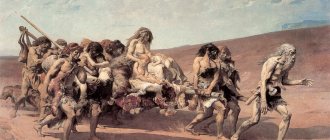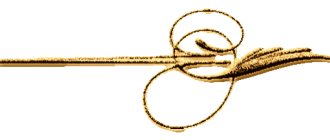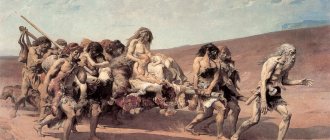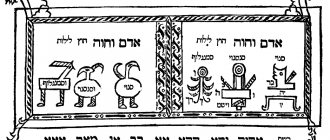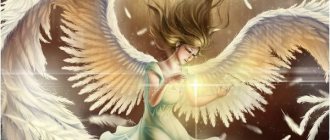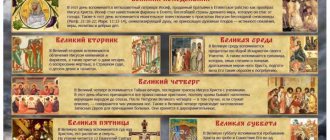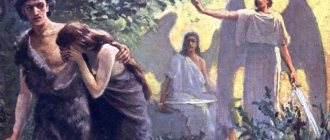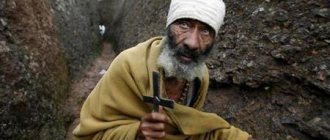Creation of life
God, having created the Earth and seeing how good it was, one might say, decided to give it to man. He created the first people, taking his image as a basis. (Gen.1:27). As he watched Adam in the Garden of Eden, he realized that a husband needed a wife. In the oblivion that overcame Adam, Eve appeared. The wife came out of her husband's rib. And the Lord God caused the man to fall into a deep sleep; and when he fell asleep , he took one of his ribs and covered the place with flesh” (Gen. 2:21).
They lived in paradise until they encroached on the forbidden fruit of the Tree of Good and Evil. Having learned about this, God did not remain merciful to his creatures. They had to become exiles from Eden. In order to never allow people to reach the Tree of Life, a cherub remained near it as a guard. “He placed a cherubim and a flaming sword that turned toward the garden of Eden on the east to guard the way to the tree of life” (Gen. 3:24). After all, having eaten from the Tree of Life, Adam could live forever.
PORTAL CONTACTS
The great holiday is getting closer and closer - the celebration of the Incarnation of God, the birth of the Infant God. The two Sundays (or two weeks) preceding Christmas are called the Week of the Holy Forefathers (this year - December 30) and the Week of the Holy Fathers (coinciding with Christmas Eve - January 6). On these occasions the Church remembers the Old Testament righteous, including the ancestors of the Savior according to His humanity. During the Divine Liturgy we will hear the Gospel of Matthew, its very beginning: “The genealogy of Jesus Christ, the Son of David, the Son of Abraham. Abraham gave birth to Isaac; Isaac gave birth to Jacob; Jacob begat Judah and his brothers; Judah begot Perez and Zerah by Tamar..."
Alexey Kashkin, head of the Biblical Department of the Saratov Orthodox Theological Seminary, our long-time and constant interlocutor, answers questions about the earthly genealogy of our Lord and Savior, about its significance for us, today's Christians.
— Alexey Sergeevich, to begin with, let us remind readers that the genealogy of Jesus Christ is also contained in the Gospel of Luke (3, 23), but there it is stated differently: not down, but up the flow of time, into the past, and not before Abraham, but before Adam, and then - the Creator Himself.
Why was it so important for the evangelists to give the genealogy of the Savior? What are they showing us this way? — There are many genealogies in the Old Testament; one might say that it all represents a huge family tree. For the ancient Jews, family records were very important, because through belonging to one’s clan, to one of the twelve (according to the number of sons of Jacob-Israel) tribes, a person felt his involvement in the events of Sacred history, felt himself to be part of God’s chosen people - the people about whom God spoke to the forefather Abraham: And I will establish My covenant between Me and you, and I will greatly, greatly multiply you (Gen. 17 :2). Let us remember how Christ Himself said about the repentant publican Zacchaeus: now salvation has come to this house, because he is also a son of Abraham (Luke 19 :9). But the main purpose of the given genealogies is to show that the Messiah, Christ, comes from the house of David and from the tribe of Judah. After all, it is precisely this origin of the Messiah that the Old Testament prophetic promises speak of: The scepter will not depart from Judah, nor the lawgiver from between his feet, until the Reconciler comes, and to Him the submission of the nations (Gen. 49:10 ). And a branch will come from the root of Jesse, and a branch will grow from his root (Isa. 11 :1).
- Joseph was not the father of Jesus in the flesh, the Infant God was conceived by the Holy Spirit; Why do both evangelists, Matthew and Luke, reporting this, cite the genealogy of Joseph and seem to see no contradiction here? Luke, however, makes a reservation: he was, as they thought, the Son of Joseph... (3, 23). But, if you just thought, why the pedigree of the imaginary father? It would be more logical to present the Mother’s genealogy.
- As we remember, the Blessed Virgin was the only daughter of Her parents, the holy righteous godfathers Joachim and Anna, that is, the only heir to Her father’s inheritance. According to the Jewish Law, every daughter who inherits an inheritance in the tribes of the children of Israel must be the wife of someone from the tribe of her father’s tribe, so that the children of Israel will inherit every inheritance of their fathers (Num. 36 :8). Thus, Joseph and Mary belonged to the same tribe (family). It is also possible that this law in Jewish practice expanded and, as it were, became the norm, so that all girls, regardless of whether they were the only heirs of their fathers or there were other heirs, began by that time to marry representatives of their clan. Therefore, in this case, it is enough to show the origin of Joseph to confirm: he is the son of David (see: Luke 2 , 4). Old Testament genealogies are precisely lists of male names. In addition, the Church honors the righteous Joseph the Betrothed as one of the Godfathers - it is no coincidence that it was he who was given the Son of God and entrusted with His upbringing. Joseph saved His life by taking Him with His Mother to Egypt (see: Matt. 2 , 13–15). Joseph was the guardian of His childhood; he, like Mary, looked for the child Jesus with great sorrow, having lost Him in Jerusalem (see .: Luke 2 , 42–50).
— Why are the lists of names themselves so different? For example, according to Luke, Joseph's father was named Eli, while Matthew's father was named Jacob.
— There is a version that Joseph the Betrothed was born in a so-called levirate marriage. According to Jewish law, if a man died childless, his brother had to marry his widow in order to restore the brother’s seed (see: Deut. 25 , 5; Luke 20 , 28). Eli died childless, and Jacob fathered children who were legally considered Eli's children, although in fact they were Jacob's children. Most likely, the Evangelist Matthew in his genealogy names the name of the biological father, this is indicated by the verb “gave birth”; and Luke names the name of the legal father. And since Eli and Jacob were half-brothers - sons of the same mother, but different fathers - then the threads of the genealogy diverge further and converge only on Zerubbabel. Other discrepancies can be explained in a similar way or by the skipping of several generations (the verb “begat” does not always mean “was his father”; “the one who gave birth” could be both a great-grandfather and a great-great-grandfather).
— Why does Matthew descend along the flow of time, starting from Abraham, and Luke ascends to Adam and God Himself?
— The Gospel of Matthew is the earliest; the evangelist wrote it for his fellow Jews. And the Greek doctor Luke at the very beginning of his story turns to the Greek Theophilus. And his goal is to preach the Word of God to all nations, to show its universal significance, the kinship of Jesus Christ to all humanity.
- Now let's talk about “personalities”. Who were they, what were they like - the ancestors of the God-man? After Adam, whose fall from sin was atoned for by the “new Adam” - Christ, with His sacrifice on the cross, is followed by his son Seth...
- Forefather Seth is the ancestor of the righteous on earth. Eve gave birth to Seth after her firstborn Cain committed the first murder on earth and was expelled by God Himself from the land given to Adam (see: Gen. 4 , 10–13). When Seth’s son Enos was born, people began to call on the name Lord God, that is, the first services began to take place (see: Gen. 4 , 26). The seventh from Adam is Enoch: the righteous man who walked with God and was taken in the flesh from earth to Heaven (see: Gen. 5 , 22–24). Further, among the ancestors of Christ, listed by the Evangelist Luke, we see the righteous Noah, who found grace in the eyes of the Lord (Gen. 6 , 8), and whose family was granted salvation during the Flood; and then his son Shem, who, unlike his brother Ham, whose name became a household name, showed respect for his father (see: Gen. 9 , 20–25). And among the descendants of Shem we see Terah, then the forefather Abraham, with whom God made a covenant, Isaac, born to him in extreme old age according to the promise of God, then the patriarch Jacob and Judah - one of the twelve sons of Jacob, the ancestors of the tribes. Jesus Christ is the lion of the tribe of Judah, the root of David (Rev. 5 :5).
“But among the ancestors of Christ there were not only righteous people, not only those who revered the true God. Consider the list of Jewish kings of the era preceding the Babylonian captivity - in fact, it was their fault that this happened: Ahaz, Manasseh, Amon, Joachim, Jehoiachin...
- Yes, these are the people responsible for the fall of Judea into paganism and for the Babylonian captivity. The repentance of the captive king Manasseh (see: 2 Chron. 33 , 12) could have saved him personally, since the Lord accepts the repentance of every sinner; but could not correct the situation as a whole. And the return of the Jews from Babylonian captivity and the construction of the second Temple occurred thanks to those righteous people who remained among the Jewish people. And, perhaps, thanks to the righteous kings Hezekiah and Josiah, they are also among the ancestors of the Savior.
“I would also like to hear about Zerubbabel...
— Thanks to the leader of the community of Jews who returned from captivity, Zerubbabel, the city of Jerusalem and the temple begin to be rebuilt (see: 1 Ezra 3 ). Zerubbabel is a descendant of David; the Jews who returned from slavery associate with him not only hopes for the revival of the dynasty, but also messianic aspirations. In the book of the prophet Haggai ( 2 , 23) the Lord of hosts says: On that day <…> I will take you, Zerubbabel, son of Shealtiel, my servant <...> and I will hold you as a seal, for I have chosen you. A seal in that era was something that had special value and was subject to special storage. Zerubbabel will be preserved as a seal, and the Messiah will be born in his descendants.
Christ came to save sinners, which is why among his earthly ancestors there were not only righteous people. St. John Chrysostom wrote: “Christ should be surprised not only because he took on flesh and became a man, but also because he deigned to be wicked people as his relatives, not being ashamed at all of our vices.”
- In the genealogy given by the Evangelist Matthew, there are four female names: Tamar, Rahab (Rahab), Ruth and “who was behind Urie” - Bathsheba. And each of these women has a special story. The cunning Tamar, having become a widow, deceitfully acquires children (the twins Perez and Zara) from her own father-in-law Judah (see: Gen. 38, 13–30); the harlot Rahab (see: Josh. 2) from Jericho, hostile to Israel, saves her own life and the lives of all her relatives by hiding Joshua’s spies in her house; the Moabite Ruth sets an example of loyalty to the people of her late husband and receives a reward in the form of a happy marriage with Boaz (book of Ruth); finally, Bathsheba is the fall of King David, this is his sin and repentance, immortalized by the well-known 50th Psalm; however, from this sinful relationship Solomon, the builder of the Temple, is born. But why are these women mentioned while other wives and mothers are not?
— A woman is mentioned where the events of Sacred history took a completely special and unexpected path for people; when unusual family circumstances lead to the birth of a child. The righteous Sarah, Rebecca, Rachel are not mentioned, because here everything went according to plan: the choice of a spouse, marriage, children from this marriage. But in these episodes everything is different: Tamar should not have become pregnant by her father-in-law, Boaz should not have married a foreigner born in the paganism of Ruth, the great David should not have fallen into sin... But as a result of these unforeseen events, the branch leading to the God-Man continued. Everything unexpected that invades our lives is from the Lord, whose Providence is incomprehensible to us.
Newspaper "Orthodox Faith" No. 24 (619)
Descendants of the first people
When children are born, people thank the Lord. Eve, having given birth to her firstborn, named Cain, was sure that she had acquired him from the Most High (Gen. 4:1). For the murder of Abel, born from the same womb, Cain became an exile and a wanderer.
The Great Flood puts an end to the line of Cain.
Adam and Eve also had a son, Seth. You can trace all the descendants of Seth to Noah in the fifth chapter of the book of Genesis. Lamech was confident that Noah, the most worthy of sons, could be an example and “comfort us in our work and in the labor of our hands in cultivating the land which the Lord has cursed” (Gen. 5:29).
Noah, as a righteous and pious man, was chosen by the Lord to continue the human race. God destroyed all those who were prone to debauchery and atrocities by resorting to a flood. It rained on the earth for 40 days and 40 nights. Noah and his sons Shem, Ham and Japheth were saved in the ark.
Sons of Adam
Alexander Chubenko, online magazine “Commercial Biotechnology”
“Popular Mechanics” No. 10, 2007
Using the marks left by random mutations on the Y chromosome, you can trace your ancestry through the male line back to Adam. True, not biblical.
Until recently, the question “where did it come from?..” for entire tribes and peoples was until recently resolved with the help of data from history, archeology, linguistics and other not very exact sciences. Any person could determine his personal ancestry with the help of registry office archives, revision tales, parish books - for three, five, well if for 10-15 generations.
Now any of us can determine our ancestry back to the ancestors of humanity. True, not biblical, but molecular genetic - “mitochondrial Eve” and “Y-chromosomal Adam”. The branches of the family tree of each of the 6.6 billion people living on Earth converge to them, who lived in Southeast Africa (according to the most generally accepted conditional and approximate estimates - 150-170 or 60-80 thousand years ago). Over the past centuries, notes have been added to our DNA, like visas in a passport, about the paths along which Adam’s descendants scattered throughout the world.
Map of human migrations based on Y-chromosome data. Image: Popular Mechanics
Which people reached their current place of residence by which route over thousands of years of great and imperceptible migrations, conquests, unifications and mixings? How did your ancestors personally travel around the world since they left the cradle of nations - Africa? And from which of the groups of these immigrants do you come—separately on your paternal and maternal lines? How many generations ago did the closest ancestor live, from whom you personally and any of the currently reigning persons descended in a direct line? DNA analysis can answer all these questions.
Genographic Project
Scientists have reconstructed an approximate picture of the settlement of peoples around the world before the European expansion that began after 1500 AD. Image: Popular Mechanics
The study of ethnogenomics began in the 1980s, when computers were not yet so fast, and DNA analysis methods were several orders of magnitude slower and more expensive than the current ones. Now the simplest, but fairly complete analysis of individual molecular genealogy, based on 12 Y-chromosome markers, costs $100–150, and more than sufficient, based on 37 Y-DNA markers + a complete mitochondrial DNA test, costs about $400. A number of commercial firms and public institutions have databases of tens of thousands of DNA samples, and most of them (with certain restrictions on access to personal information) are open to everyone. Due to people's interest in their individual pedigrees, information in these databases accumulates faster than scientists can process it. The most ambitious study of entire populations - Genographic Project
(“Genographic Project”), started in 2005 by the National Geographic Society of the United States
with
the support of IBM. The goal of the project is to collect at least 100,000 DNA samples over five years from typical representatives of peoples or tribes whose history is known from ethnography, history and archeology in order to clarify the routes of human migration across the Earth. In fact, such a huge sample is a drop in the bucket compared to the real diversity of races and tribes, but as information is added, the results can be refined. Even the draft plan compiled by the project participants under the direction of Dr. Spencer Wells is a fascinating sight, especially in the form of an interactive map on the project website. But first, let's understand the terms.
Molecular genealogy
When germ cells are formed from diploid precursor cells, their somatic chromosomes (and in women, sex chromosomes) exchange sections - approximately what happens if two decks of cards with backs of different colors are not too carefully shuffled and again arranged into two identical sets independently from the color of the shirts. We get a quarter of the genome from each of two grandfathers and two grandmothers, 1/8 from our great-grandfathers and great-grandmothers... Our chromosomes contain genes not only of Adam and Eve, but also of all their close and distant relatives who lived 70-80 thousand years ago , when the number of our species decreased to a critical value - approximately 10,000 individuals, and more distant ancestors, up to the first mammals and even the first multicellular animals. But from them we received only somatic and X chromosomes, the genes of which, as a result of constant mixing, spread throughout the population. Only the Y chromosome and mitochondrial DNA pass almost unchanged from generation to generation. This “almost” is the basis of all molecular genealogy, which studies history by mutations that occurred in ancestors and are preserved in the DNA of descendants.
Mutations: beneficial, harmful and neutral
Usually, large mutations - for example, moving to another place, doubling, or, conversely, the loss of a large section of a chromosome carrying one or more genes - do not lead to anything good. As, indeed, are common single nucleotide polymorphisms - SNPs, if they occur within one of the 21,000 human genes.
The nucleus of every human cell, except eggs and sperm, contains a diploid (double) set of 46 chromosomes: 22 pairs of somatic (“body”) and a pair of sex ones: XX in women and XY in men. In germ cells, the set of chromosomes is haploid - single (you cannot do without Greek terms here: chromosomal genealogy is based on the determination of individual haplotypes belonging to different haplogroups). Image: Popular Mechanics
Beneficial mutations occur much less frequently and persist in subsequent generations. Harmful - are removed from the population along with the carrier, either at the embryonic stage, or, in the case of a severe hereditary disease, before this carrier has time to acquire offspring. As a result of the action of stabilizing selection and periodic decreases in the population of the species, reducing its genetic diversity, the structure of genes in two people chosen at random coincides by 99.9%. All our differences, from skin color and eye shape to height and susceptibility to certain diseases, are determined mainly by gene polymorphisms - minor differences in the nucleotide sequences of almost identical genes and, accordingly, in the structure and functions of the proteins encoded in these genes.
Firstly, random mutations occur constantly, and polymorphisms are considered to be those that occurred a long time ago and therefore occur more often than in 1% of people in a given population (the border here is arbitrary - gene variants that occur less frequently than in 2–3%). Secondly, polymorphisms do not have a noticeable effect on the health of their carriers or are even adaptive in nature. True, the border here is quite blurred. A classic example is an SNP that causes a severe hereditary disease, sickle cell anemia, in homozygotes—carriers of two mutant genes. But heterozygotes for this gene—carriers of a healthy variant on one chromosome and a “spoiled” one on the other—are less likely to get malaria, and experience symptoms of anemia only in extreme conditions, for example, in the highlands. This mutation is found in southern India, the Mediterranean, and in West Africans and their descendants on other continents.
When chromosomes are copied, “snaps” occur with a probability of 10–8 per nucleotide per generation. With a haploid genome size of 3 billion (3 × 109) nucleotides, each child has on average about 30 single-nucleotide differences from its parents due to random point mutations. Fortunately, most of these mutations occur not in genes, but in so-called junk DNA - approximately 95% of the human genome that does not code for proteins or service RNAs. These mutations do not affect anything, selection is indifferent to them - so they are preserved among the rest of the genetic “junk”. It is these, as well as short tandem repeats (see sidebar), that are used in molecular genealogy as chromosomal markers—characteristic features.
Boys and girls
Let's start with Adam: it's easier to understand male molecular genealogy (however, ladies can also find out everything said below about their origin in the male line - for this you need to analyze the DNA of your father, or brother, or uncle - any direct paternal relative).
The generally accepted classification of Y-chromosome lineages is based on the sequence of appearance of SNP markers on it. On the family tree of modern men, 18 main branches are identified, designated in Latin letters, from the first branch at the very root - A to the latest - R. This classification takes into account approximately 250 markers, according to which about 170 final “branches” are now identified, each with its own a set of sequential mutations. As new markers are identified, new branches are added to the diagram. Each of the modern branches of the molecular family tree differs from Adam by about two dozen different mutations in different parts of the Y chromosome. Image: Popular Mechanics
About 300 million years ago, in the first mammals, one of the chromosomes, which carries, among others, several genes that determine male gender, began to lose the remaining genes and, along with them, the ability to exchange sections of DNA with the paired chromosome. In humans, there are only 27 genes left on the Y chromosome, most of them work in the testes. The rest of the Y-chromosomal DNA is useful only for ethnography and genealogy. Mutations—deletions, substitutions, or additions of single nucleotides (SNPs) and changes in the number of repetitions of three to four identical nucleotides (STRs)—occur in different parts of the Y chromosome at different frequencies, with an average of one mutation every 500 generations. In the most conservative areas, mutations occur once every 100,000 years.
Y-chromosomal Adam lived approximately 80,000 years ago, but "once in 100,000 years" is the probability of mutation in this part of the chromosome in a continuous series of generations, and it can be calculated that even such a rare event could occur once per generation in about one out of 3,000 father-son pairs. The time and place of life of our common direct ancestor was calculated by analyzing the distribution of Y-chromosomal markers in populations from different regions of the planet. They are used both for research in the field of ethnogenomics and for elucidating individual genealogies.
History and geography
Among the population of ancient Russian cities, haplogroups R1a, I1b and N are most often found. Very conditionally, their carriers can be called descendants of the Eastern, Southern and Northern Slavs, respectively. In fact, the mutation that determines membership in the R branch supposedly appeared in northwest Asia 30–35 thousand years ago: in a tribe in which all the men (or most of them) belonged to the earlier haplogroup P, a boy was born, in Y- chromosome of which there was a malfunction - the replacement of just one nucleotide, adenine with guanine. His descendants settled throughout Europe and western Asia, mixing with local tribes along the way, but all of his direct descendants retained this mark - marker M207. It was also found among men from one of the isolated tribes of Cameroon - most likely, these are descendants of part of a prehistoric tribe that returned from Eurasia to Africa.
Slavic Marketplace
Subgroup R1a (M17) originated in the steppes of what is now Ukraine and southern Russia 10–15 thousand years ago. The tribes of the Kurgan culture, known from archaeological data, were among the first to domesticate the horse and, due to this, settled almost throughout the continent, conquered the natives, mixed with them and imposed on them their language and religion, which became the basis of Proto-Indo-European (Indo-Aryan) culture. Direct descendants of the Indo-Aryans include 45% of men in the upper castes of India, 40% of Poles, northern Russians, Ukrainians, Belarusians, Latvians and Lithuanians. Slightly less common are the southern and western Slavs, Icelanders (Rurik was also a Viking), East Germans and the peoples of Russia, whose language belongs to the Finno-Ugric group (millennia of neighborhood have long mixed up “Rus, Mordovians and Chud”). Despite all the mixing of tribes, carriers of the R1a subgroup in southern Russian cities make up 55% of the male population, and in central Russia - up to 70%. But if anyone decides, on the basis of belonging to this subgroup, to be proud of their Aryan blood, we remind you: your relatives live in the Kalahari Desert, and further around the globe to Greenland, Australia and Tierra del Fuego. By the way, among the Kazakhs - in all other respects typical Mongoloids - there are no fewer carriers of the R1a subgroup than in Russia. Yes, we are Scythians...
One of the great-great...great-grandchildren of the ancestor of haplogroup R, who moved little by little to the south, had another mutation, M127, 25,000 years ago. Its carriers, representatives of haplogroup R2, make up 5–10% of the population of southern Central Asia, Pakistan and northern India. Another branch of this group turned west, to the lands from which the last glacier was sliding. The R1 subgroup, which added the M173 mutation to previous marks on the Y chromosome approximately 30,000 years ago, is the most common in Europe and western Eurasia.
Ethnogenomics deals with mutation probabilities derived from approximate calculations, samples from populations, and other statistical averages. Even the number of millennia in the calculations depends on what time of generation change, from 20 to 35 years, the authors of the work choose. The closest approximation in time that a haplogroup shows even with the longest alphanumeric index is the probability of occurrence of one SNP, at best 5000 years, so the details of individual genealogy cannot be determined from it. One can only argue that more than a third of the inhabitants of northern India, almost half of the Russians and almost a third of the Norwegians are related to each other in the two hundredth or three hundredth generation.
Genealogy
Is it possible to build a human family tree with higher accuracy? It is possible, but SNPs are not suitable for this. For detailed studies in molecular genealogy, short tandem repeats (STRs) are used. During the formation of sperm, enzymes that copy the DNA of the precursor cell sometimes skip or add one of the repeats to such a tandem. If this sperm takes part in the birth of a boy, all of his sons, grandchildren and great-grandchildren will retain a new entry in this marker until the direct male lineage ends - or until the next mutation in the same STR. A repeated mutation can increase or decrease the difference, making the differences between the branches of the tree clearer, or it can restore the original state. But when using a large number of markers, the degree of relationship can be established quite accurately.
Keys to the family tree
DNA is a sequence of nucleotides, which are designated by the letters G (guanine), T (thymine), A (adenine) and C (cytosine).
For example, a DNA fragment could be like this: ...GTACAAGAG(TAGATAGATAGATAGATAGATAGATAGATAGATAGATAGATAGATAGATAGATAGA)CTGGTG... Or like this: ...GTACAAGAG(TAGATAGATAGATAGATAGATAGATAGATAGATAGATAGATAGATAGATAGATAGATAGA)CTGGTG...Notice the repeating combination. This is STR ( short tandem repeat
). From time to time, in the “junk” part of DNA there are such meaningless repetitions of three or four nucleotides, in this case TAGA (thymine-adenine-guanine-adenine). This is the first of the most commonly used Y chromosome markers, DYS19 (DNA Y-chromosome Segment No. 19), and the example combinations are designated DYS19=14 and DYS19=15.
Now let's look at another sequence: ...GTACTAGAG(TAGATAGATAGATAGATAGATAGATAGATAGATAGATAGATAGATAGATAGATAGA)CTGGTG...
This is very similar to the first sequence, but at the fifth nucleotide there is a change from adenine to thymine. This is SNP - single nucleotide
, "snip") Y chromosomes. Key “snips” unambiguously determine a person’s haplogroup, that is, a “branch” on the tree of human migrations. A set of STR markers on the Y chromosome determines a person’s haplotype. When comparing the haplotypes of two people, it is possible (if the haplogroup matches) to approximately determine the number of generations to the nearest common ancestor in the male line.
All men on Earth have tandem repeats of varying lengths at loci DYS19, 388, 390, 391, 392 and 393. For example, the TAGA quadruplet (DYS19) can be repeated from 10 to 19 times, the ATA triplet (DYS388) - 10-16 times, etc. In 98% of men, DYS385 was added to the basic set of six common markers inherited from chromosomal Adam - from 7 to 28 repetitions of “GAAA”. 34% also have DYS438 and 439, etc. The most informative of the almost five hundred STRs discovered on the Y chromosome were selected as genealogical markers. Standard DNA genealogical tests are carried out using 12, 25, 37 or 67 markers, although six are often enough to assign the “owner” of this haplotype (individual set of markers) to one of the haplogroups, from A to R, based on the combination of the number of repeats. For example, the so-called “Atlantic modal haplotype”, most common in western Europe, looks like this: DYS19=14, DYS388=12, DYS390=24, DYS39=11, DYS392=13, DYS393=13. A person with such a haplotype is almost 100% likely to belong to haplogroup R1b or its subvariants.
The smaller the differences in the number of repeats of nucleotide groups in all analyzed DYSs between two haplotypes, the greater the likelihood that their carriers are relatives. In a test using 37 markers, the probability of all of them matching by chance is 1/637, 1 chance in 6 × 1028 (remember, the Earth’s population is 6.6 × 109). Even with 12 markers, the probability of a random match is 1 chance in more than two billion, and if someone’s DYS completely matches your haplotype (and the haplogroup matches), you can be sure that you have found a brother, father, uncle or “much cousin” (but no more than tenth to fifteenth generation) of a relative in the direct male line. What could happen if in such a database you find a sequence of numbers that differs from yours by 1, 2 or 5 units? You can estimate how many generations ago your closest common ancestor lived. Divergence by one repeat in any of the markers occurs on average once every 500 generations, approximately once every 15,000 years. In a haplotype of 37 markers, one mutation can occur approximately once every 13 generations, or 300–400 years. Although the average mutation rates in different DYSs differ, they are known, so the possible timing of divergence can be further refined. True, it will still be just a probability, but then it will be possible to delve into paper data, from family archives to chronicles. And in any case, you will learn a lot of interesting things, especially if you add mitochondrial DNA analysis to the information about the Y chromosome. But read about maternal kinship in the following issues.
We thank Anatoly Klyosov for his help in writing the article.
The material was prepared with the assistance of National Geographic Russia magazine.
Nations descended from the sons of Noah
Noah and his children restored life on Earth. “From them the nations spread out on the earth after the flood” (Gen. 10:32). The Book of Acts specifies that each nation was assigned “predestinated times and bounds for their habitation” (Acts 17:26). Magog and Madai, Gomer, Meshech, Javan, Tufal and Tiras are called the sons of Japheth. But in ancient Greek the Septuagint mentions an eighth son - Elis.
Descendants of Japheth
The descendants of Japheth are called Japhetids. They settled throughout Europe.
Descendants of Ham
Ham, who told his brothers about his father's nakedness, paid for his shameless act. Noah punished his son Canaan by assigning him to be a slave to the followers of Japheth.
From the sons of Ham, Cush, Fut, Canaan and Mizraim, begins, as A. Lopukhin clarifies in his comments to the Bible, the settlement of Asia, or rather its south, and the upper reaches of the Nile. Ham acts as the ancestor of the four races living in the mentioned places.
The descendants of Ham were strong. Specifically, Genesis 10 states the power of Nimrod , the son of Cush. Assur, who came from the lands of Nimrod, built cities. “And Ressen between Nineveh and Calah; it is a great city” (Gen. 10:12).
Descendants of Shem
Noah's eldest son Shem is the ancestor of the Semitic peoples. At the age of one hundred years, he becomes the father of Arphaxad (Gen. 11:10). Later - Assura, Elama, Lud, Arama. But along the line of Arphaxad the birth of Abraham occurs. His name means "father of multitudes." The New Testament, clarifying the genealogy of the Savior, refers to Abraham (Matthew 1:1).
And although Sarah, Abraham's wife, was barren, the Lord predicted a blessing for him and a great nation as descendants, numerous like sand that cannot be counted (Gen. 12:2; 13:16). From God, Abraham also knew about the oppression of his descendants for 400 years and the heavenly judgment of the enslavers.
As the years passed, Sarah remained childless. Abraham's first son was Ishmael, born to his maidservant Hagar. But the Lord assured that a son would appear from Sarah, “kings of the nations would come from her” (Gen. 17:16). Isaac was born to Sarah and Abraham in old age. Despite the long wait for the birth of his son, Abraham was ready to sacrifice Isaac at the command of the Lord. The need for sacrifice arose, as John Chrysostom writes, “not for the actual slaughter of a son, but for the discovery of all the virtue of the righteous.”
Isaac and his wife Rebekah also prayed for children for a long time. They waited for twins, named Esau and Isaac.
Isaac, blind over the years, who loved his son Esau, succumbed to deception . By posing as his older brother, Jacob received his father's blessing that was not intended for him.
Jacob paid for his actions in some way. Wanting to marry Rachel, he served with her father Laban for several years. But he, dreaming of marrying off his eldest daughter first, brought Leah to Jacob. When the forgery was revealed, Jacob stayed with Laban for another seven years. It happened that Jacob received a new name. He happened to enter into a fight with “Someone” (Gen. 32:24). It turned out that Jacob with his stubbornness defeated God himself, and therefore called him Israel, capable of defeating many: “... from now on your name will not be Jacob, but Israel, for you have fought with God, and you will overcome men” (Gen. 32:28). Often the descendants of Jacob are identified as Israelites.
Jacob had 12 sons. The mothers of Reuben, Levi, Simeon, Issachar, Zebulun, Judah, Benjamin, and Joseph were his wives Leah and Rachel. Naphtali, Dan, Asher and Gad were given to Jacob by their maidservants wives, whose names were Zilpah and Bilhah.
Israel had the most tender feelings for Joseph as the “son of old age.” For this alone his brothers disliked him. And when Joseph dared to tell more dreams about the sun, moon and 11 stars bowing to him, and about sheaves of brothers bowing to his sheaf, hatred filled his family. A terrible fratricide was being prepared. However, Judas offered to sell the “ dreamer ” into slavery, which was done. The name of Judas attracts attention not only in this story. It plays an important role in the genealogy of Jesus Christ.
Chapter 5
Gen.5:1-2. Here is Adam's genealogy:
This is the title of a whole new section (toldoth), like the previous one (Gen. 2.4) and a whole series of subsequent ones (Gen. 10:1, 11:10, 27, 25:12, 19, 36:1, 37:1). Translating this title of the history of the Sethites into the language of modern concepts, we would have to say: “here is a list of the descendants of Adam.” And since further on we are talking only about the Sethites, then, obviously, this list does not apply to everyone, but only to the descendants closest to him, related to him not so much in the flesh as in the spirit.
when God created man, in the likeness of God he created him,
male and female he created them, and blessed them, and called their name man on the day of their creation.
When starting to list the descendants, the writer of everyday life, not without purpose, mentions the creation of the ancestor and his wife in the image of God. Perhaps he wanted to inspire the reader that the listed descendants of Adam through him descend as if from God himself; that God, who created Adam in his own image and likeness, is, as it were, the first member of the genealogy (Luke 3.38), (Vissarion).
Gen.5:3. Adam lived one hundred and thirty [] years
In the presentation of the genealogical table itself, the biblical author, starting with Adam, always adheres to the same order: naming the name of a famous patriarch, he indicates his age at the moment of birth of the next member of the genealogy, then determines the number of years of the rest of the life of this patriarch, sums up his longevity and ends it all with a mention of his death.
In some chronological dates, mainly those relating to the time of the birth of one or another patriarch’s son, there is a disagreement between the Russian and Slavic texts, which occurs due to differences in the Hebrew and Greek Bibles. This difference, in all likelihood, is of accidental origin (introduced by some translator or scribe) and in any case does not have any serious significance for the essence of faith, clearly proving only the obvious truth that the Bible does not have an exact chronology, and the existing one is rather arbitrary and relative, and, at least in some of its departments, in all likelihood, was added to it later.
Another, even more important question related to this antediluvian genealogy is the question of the amazing longevity of its members, reaching almost a whole millennium. In contrast to the tendentiousness and unfoundedness of rationalistic attempts to undermine faith in patriarchal longevity, its recognition has a whole range of valid evidence. First of all, the fact of man's previous heavenly immortality speaks for him: although man lost this divine gift through the Fall, the infection of mortality could only gradually crush the primitive strength of the body. The same thing, further, is evidenced by the analogy of the patriarchal period with human childhood: the patriarchal antediluvian period was a kind of era of infancy in the life of mankind, that is, a time of special wealth, integrity, productivity and freshness of all its spiritual and physical forces.
The validity of this, to a certain extent, is confirmed by a number of parallel legends of other ancient peoples, recorded by the Egyptian priest Manetho, the Phoenician priest Mochos, the Chaldean priest Berosus, and others. Finally, an important confirmation, and at the same time the best explanation of the fact of patriarchal longevity, is the obvious action of divine Providence, who through his means carried out high religious goals: the preservation of religious truth, the spread of the human race and the establishment of the basic elements of religion, morality and culture (for more information on this, see I. Spassky, “Biblical Chronology”, Plastov, “The Sacred Chronicle” and A. Pokrovsky, “ Biblical teaching about primitive religion").
and he begat [a son] in his own likeness [and] in his image, and called his name Seth.
These words quite expressively establish the innateness of the basic spiritual and physical properties of human nature; Because of this, Adam’s offspring received both the features of the image of God inherent in his nature and the properties of that sinful likeness that darkened this divine image in the fact of the Fall (Gen. 1:26, 3:19; Rom. 5:12).
Gen.5:4. The days of Adam after he begat Seth were eight hundred [] years, and he begat sons and daughters.
The Bible names three sons of Adam and Eve and one daughter, presumably the wife of Cain (Gen. 4:17); but in addition to these, as can be seen from the above words, they probably also had sons and, undoubtedly, daughters, who are not mentioned here because they were not of significant importance in the history of the divine economy. We have completely similar news about the families of other patriarchs of this genealogy (Gen. 5:7-26, etc.), from which we are once again convinced that this genealogy does not represent a complete list of all Sethite clans, but notes only selected individuals than - especially prominent in the history of human salvation.
Gen.5:9. Enosh lived ninety [] years and begat Cainan.
Philological analysis of the name of this patriarch reveals the identity of its meaning with the name “Cain”, i.e. “acquisition, possession”; and this, of course, does not cast any unseemly shadow on this pious Sethite, since the very name of Cain, according to the idea contained in it, was significant and bright (Gen. 4:1).
Gen.5:12. Cainan lived seventy [] years and begat Maleleel.
which translated means: “praise, glory to God, or one who praises, one who glorifies Him.” This obviously indicates the prosperity of religious interests under Cainan, the son of Enosh, the first organizer of the service of God, in which a prominent place was occupied by the solemn invocation and glorification of the Creator (Gen. 4:26), the Provider of the world and the Redeemer of mankind.
Gen.5:15. Mahleleel lived sixty-five [] years and begat Jared.
Derived from Hebrew. the verb jarad - meaning "to descend, descend", the name of this new patriarch indicates him as a person from somewhere "descending, descending, falling." Keeping both the literal and figurative meaning of this word, we have the right to assume that here we are talking about both the physical descent of the Sethites from some height and their moral decline. Since the generation of Jared, the fifth from Adam through Seth, was contemporary with the generation of Lamech, the fifth from Adam through Cain, and since, on the other hand, there is a tradition that originally the Sethites lived on the heights, and the Cainites in the low valleys, it is not without plausibility and the opinion according to which the Sethites, carried away in the age of Jared by the beauty of the Cainite women of their time (led by the beautiful Noema, Gen. 4:22), descended from their heights into the valleys of the Cainites, entered into criminal relations with them, and through this fell morally . This opinion, based on philology, is also based on the ancient Jewish tradition, listed, among other things, in the book. Enoch.
Gen.5:18. Jared lived one hundred and sixty-two years and begat Enoch.
The name of this patriarch, already known to us from the genealogy of the Cainites, indicates its bearer as a renovator, a pioneer, a sanctifier, in a word - something new and, as the firstfruits, dedicated to God. But while Enoch the Cainite was the beginning of worldly power and their cultural dominance (expressed in the construction of the first city of the same name), Enoch the Sethite, on the contrary, was a typical representative of primitive faith, hope and piety, in a word - everything that is united in the Old Testament concept of “righteousness.”
Gen.5:21. Enoch lived sixty-five years and begat Methuselah.
Literally translated from Hebrew, this name, according to authoritative Hebraists, means: “man of the arrow, man of weapons.” Since, according to a more probable calculation, Methuselah died in the very year of the flood, they find it possible to see in his name a symbolic indication of his death from this arrow of divine wrath, that is, from the flood. And this is all the more likely because Methuselah’s father, the righteous Enoch, according to the Apostle Jude (Jude 1:14–15), prophesied about the flood and, therefore, in the spirit of this insight, could easily give the corresponding name to his son.
Gen.5:22. And Enoch walked with God
A similar expression is found in the Bible several times (Gen. 6:9; Mic. 6:8; Mal. 2:6, etc.) and everywhere it means the highest degree of moral direction in a person’s life, when he began to be deeply imbued with a reverent sense of divine omnipresence, that With the eyes of faith, it is as if he constantly sees God before him, and in strict accordance with this he coordinates the entire image of his behavior and every step of his life. This expression is even somewhat broader - namely, it contains a hint of the consequences of such good behavior, in the form of a special and exclusive closeness to God, as it is conveyed in the Slavic text: “and please... Enoch God,” also the Apostles Paul (Heb. 11:5) and Jude (Jude 1:14).
Genealogy from Judah son of Jacob to Joseph the betrothed
Great kings come from the tribe of Judah. One of them is David, who carried the Ark of the Covenant to Mount Zion, in which the stone Tablets of the Covenant with the Ten Commandments were kept. Another is Solomon, who built the Temple of Jerusalem. Their descendant was also Joseph the Betrothed. The New Testament traces the story from Abraham to Jacob the son of Matthan. There we also find the secret of the birth of the Savior. A descendant of Jacob, the son of Matthan, was Joseph, who became the husband of Mary.
There are 42 tribes in total from Abraham to Joseph the betrothed. Thanks to a careful study of various sources, it seems possible to draw a diagram of the genealogy of Adam and Eve.
Rate this post
The following two tabs change content below.
- Author
- Latest articles
ELENA Kapitanova
Tree of Life: the story of Adam and Eve in the Bible and in hadiths from the Imams (A)
Both the Koran and the Bible talk about a certain “tree” from which Adam and Eve “ate”, after which they lost their original paradise state.
In the hadiths from the most pure Imams (A) it is mentioned that this tree is a symbol, an investiture of the power and divine chosenness of Muhammad and the family of Muhammad (peace be upon them). Imam Askari (A) said: “Allah, great and holy, cursed Iblis for his disobedience, and bestowed the angels with bow to Adam and submission to Allah, commanded Adam and Eve to live in Paradise (jannat) and said: “O Adam! Settle you and your wife in Paradise and eat from there" - that is, from Paradise - "for pleasure" - that is, an extensive inheritance, - "wherever you wish" - without difficulty, - "but do not approach this tree" - that is, the tree of knowledge , the tree of Muhammad and the family of Muhammad, peace be upon them, through which Allah singled them out from all creation, and this tree is only for Muhammad and the family of Muhammad, and no one eats from it (fruits) by the command of Allah except them.”
Tafsir “Burkhan”, vol. 1, p. 178-180; "Tafsir Askari", p. 221
A modern researcher of biblical-Muslim parallels, Thomas Mac Elwein, writes:
“There is a parable about Adam in which it is said that after he ate the fruit of the tree of the knowledge of good and evil, his skin became discolored. Then the Almighty told him the names of the 12 Imams, and after Adam repeated them, the color of his skin became original. The Bible characterizes the "discoloration" of Adam's skin as his nakedness.
The parable contrasts two ways of reaching a verdict about the essence of good and evil: the tree of the knowledge of good and evil (an attempt to independently come to a conclusion) and the tree of life (the knowledge of good and evil with the help of God-appointed leaders - from Prophets to Imams). Here lies the biblical prophecy about the 12 Imams. In Genesis 2:9, the phrase “tree of life” is mentioned, which in Hebrew consists of 7 letters, in the following order: “ayin”, “tsade”, “he”, “Hett”, “yod” (repeated twice ) and "meme". Despite the fact that there are 12 imams, the number of their names is 6. Three of them are repeated. Four Imams were called Ali, two were called Hasan, three were called Muhammad, while the names Hussein, Jafar and Musa were used once each...”
The 87th verse of Surah Hijr says: “We have given you seven repeatable (masani) and the great Quran.” "Masani" is the plural of "masna", literally meaning "repeated" and also "rhymed lines" (as rhyme is repeated). “Seven repeated” could mean that there are seven names of the Immaculate Ones from Ahl al-Bayt (A) and some of them were repeated. Six of these names are male, as mentioned above, and one is female: Ali, Fatima, Hasan, Hussein, Muhammad, Jafar, Musa.
“...The first letters of the names of the Imams in the Hebrew transcription of the “tree of life” correspond to their names. “He” and “Hittite” for Hassan and Hussein; "ayin" - Ali; Musa and Muhammad - “meme”. Standing apart is Jafar al-Sadiq, the creator of the Jafari madhhab and transmitter of the Ahl al-Bayt hadith. Although the name “Jafar” in Hebrew begins with the letter “jimel,” the name “Sadiq” begins with “tsade.” There remain two letters “yot” in the middle of the word. The letters “yot” repeated twice in Hebrew are used as an abbreviation for the name of God.”
Thus, Mac Elwein rightly asserts that the initials of the Imams (A) are hidden in the phrase “tree of life,” which is periodically mentioned in the Bible and in Shiite hadiths as a symbol of the imamate. It is also mentioned in the Psalter. Psalm 1 speaks of an ideal man who puts into practice divine revelation, and of a tree that bears fruit in its season (that is, there is an Imam for each time). Psalm 3 speaks of it as the tree of life whose leaves do not wither. Jesus, speaking in the Sermon on the Mount about distinguishing between true prophets and liars, says: “By their fruits you will know them.” In turn, the Revelation of John mentions the tree of life “bearing fruit twelve times” (22:2). That is, we recognize the prophet who will come after Jesus - Prophet Muhammad (DBAR) - by his 12 fruits - Imams. It is no coincidence that Imam Ali (A) says: “We are the tree of prophecy, the place where revelation descends, angels descend and ascend” (Nahj al-balagha, VI-109).
If you liked this material, then help create new ones - support the project! You can do this here: Every ruble you transfer is another step towards the victory of Truth.
